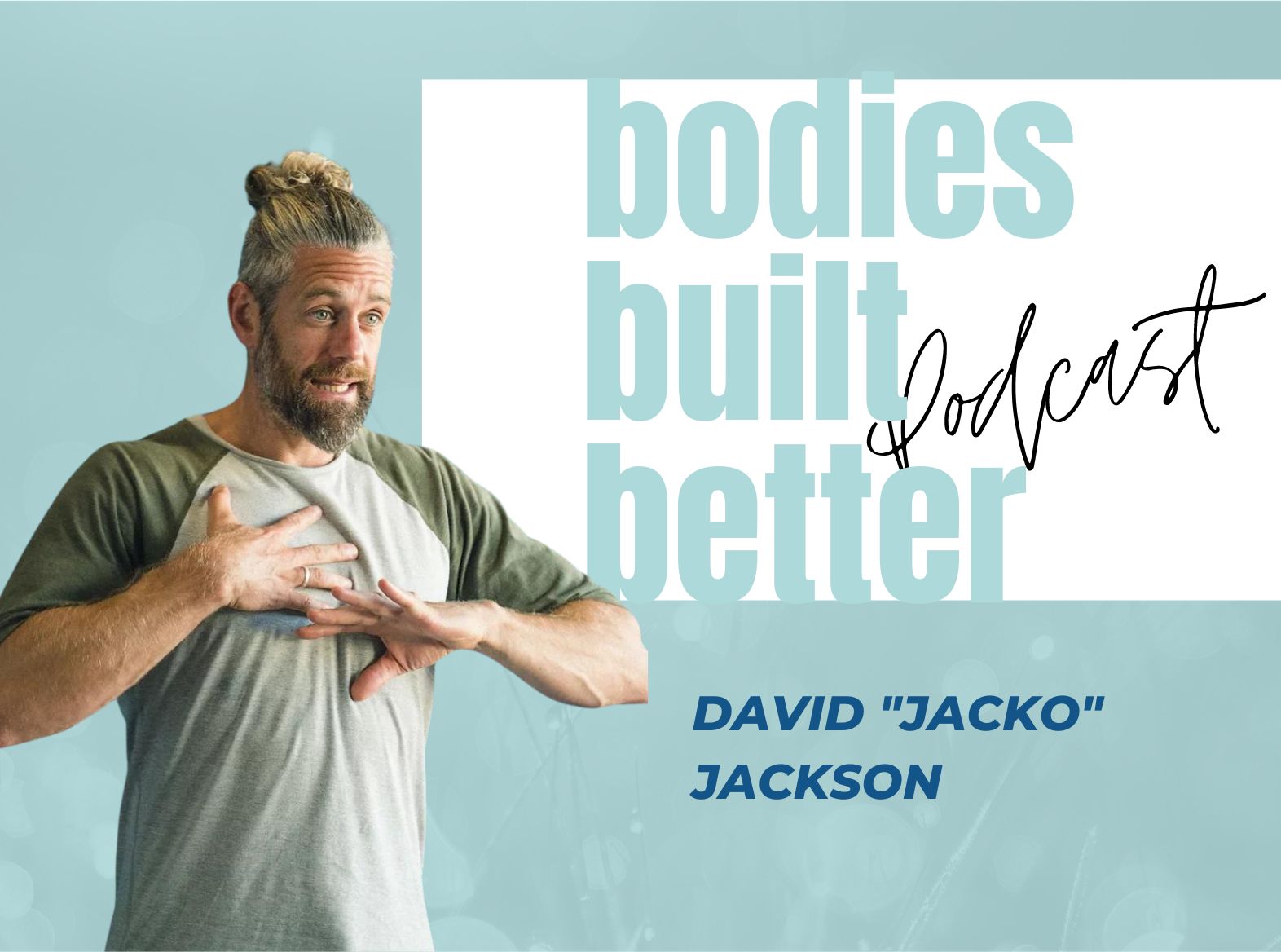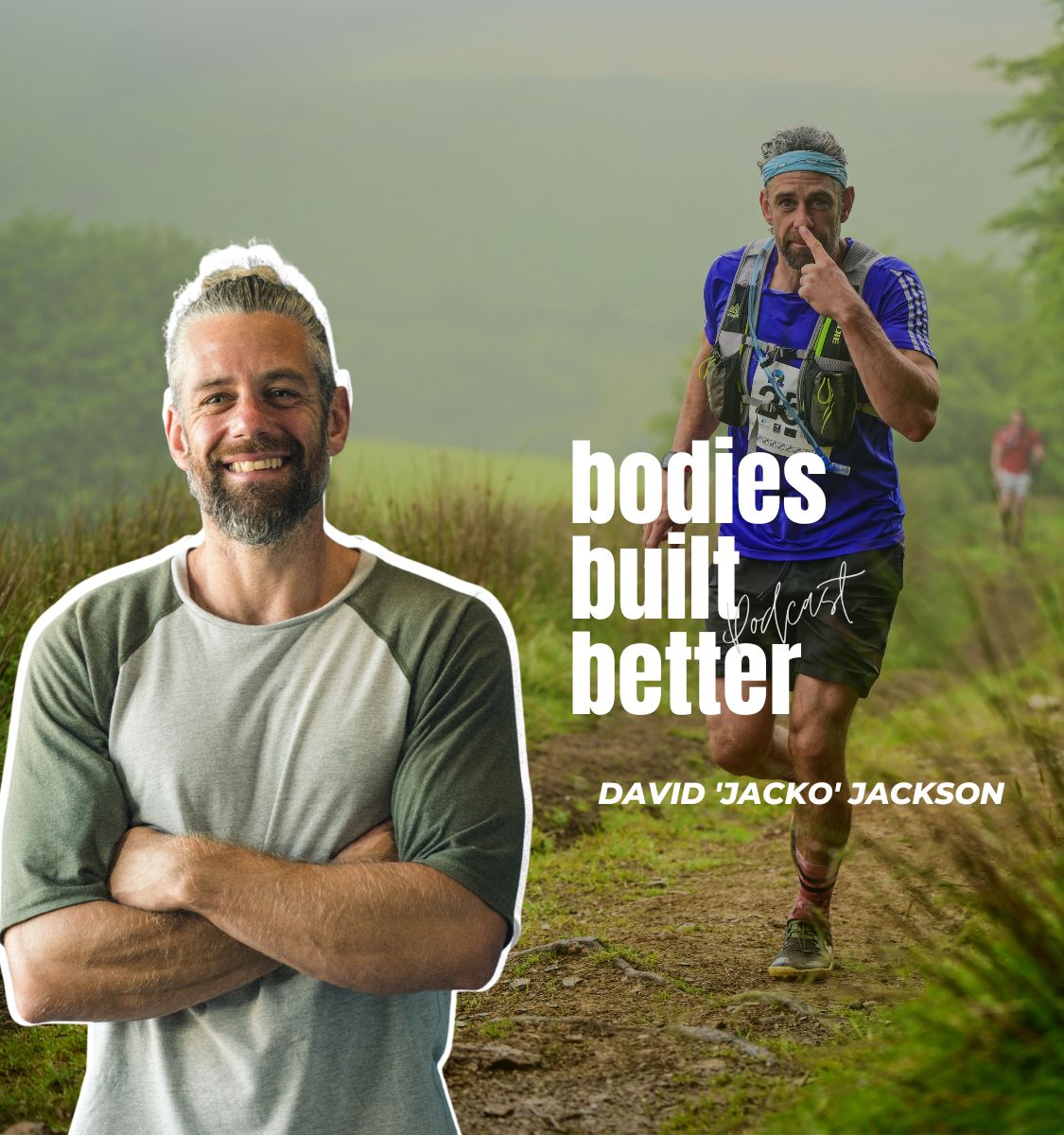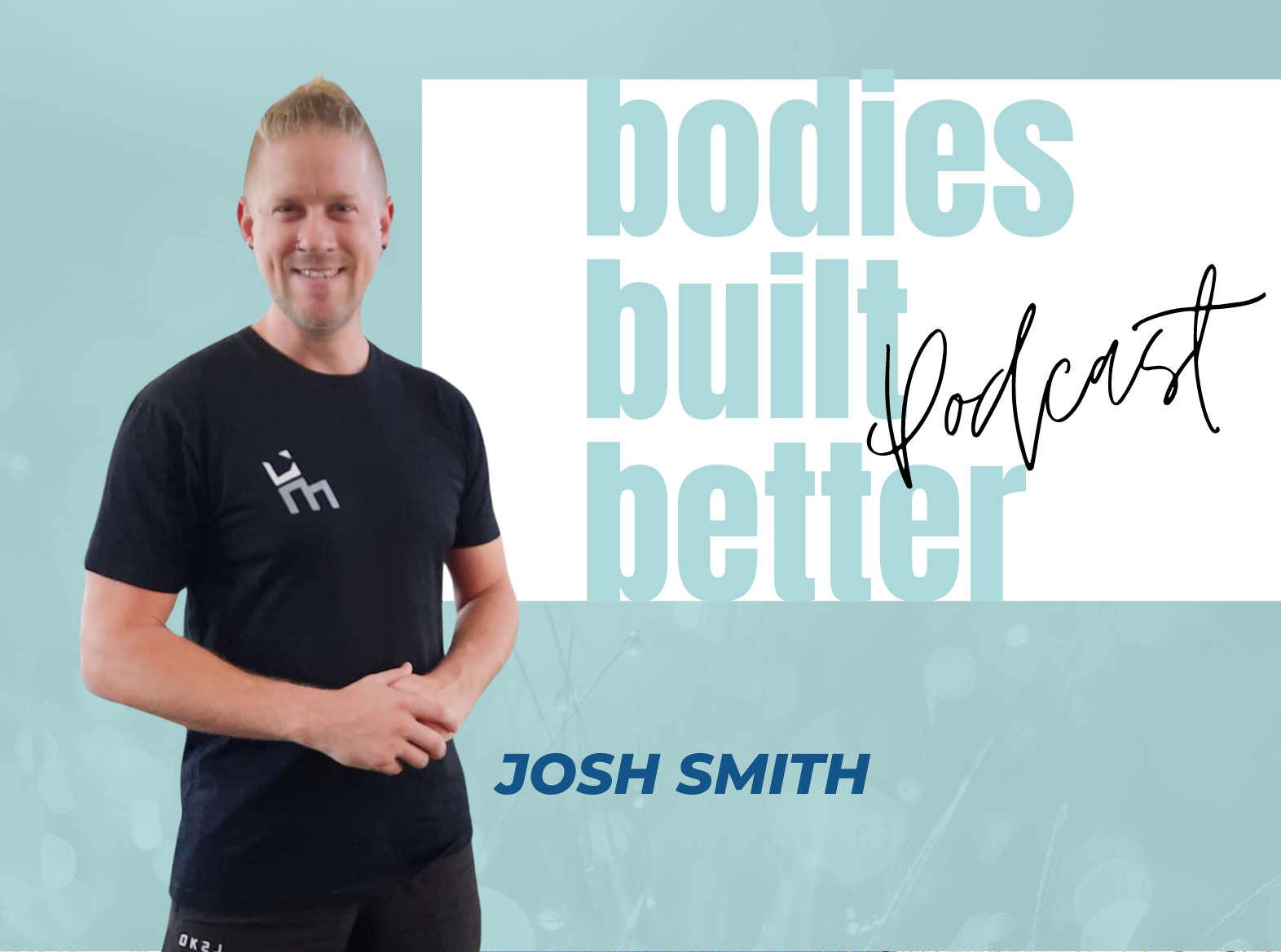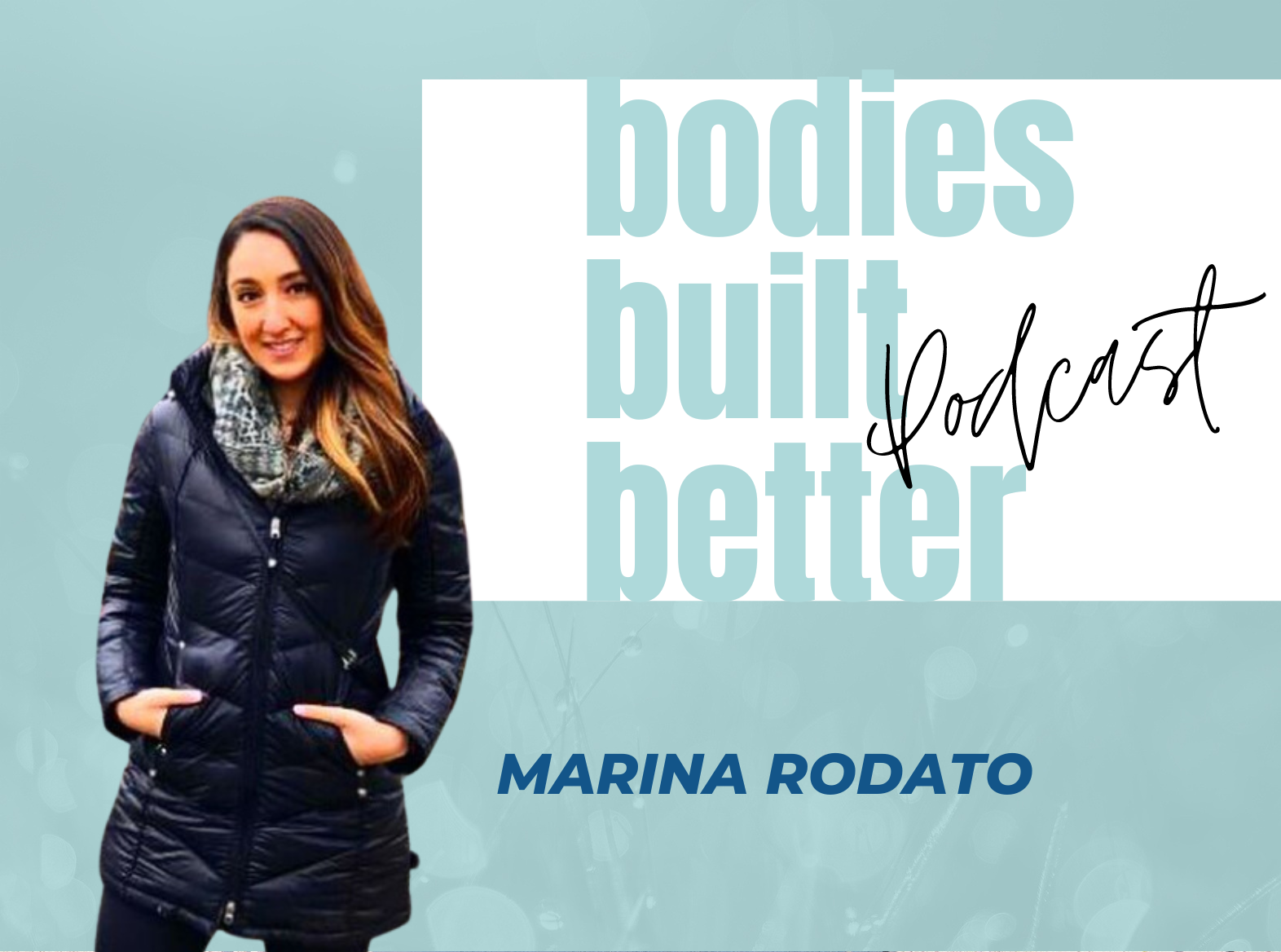How Jacko’s Athletic Career Led Him To The Path To Healing
Jackie 4:09
Jacko, thank you so much for chatting with me today. Welcome to the Bodies Built Better podcast.
Jacko 4:14
Thank you. I feel like I’m actually in Australia is so hot right now in the UK. Literally lie and die.
Jackie 4:21
Which would explain in a minute.
Jacko 4:22
For sure, it’s a promise but I won’t. Yeah.
Jackie 4:29
Brilliant. Well, you are a master oxygen advantage instructor. You’re teaching people all over the world and you’re working with clubs and athletes as well and improving their performance with breath work, which I’m really looking forward to diving deeper into today. But before we do, you were a pro rugby player, and your career was cut short, and I’ll let you get into why. But I feel like that’s a really great place. or introduction to start with, because I feel like that kind of led you down this path of breath work.
Jacko 5:08
Yeah, no, no, you’re right. I heard you were saying that, was like, I’m trying, we’re all trying to I’m trying to do these things. And I, I tried to, I try to play to be myself, you just told me that you’re, you’ve done the maths, you’ve done the, the, the actual entity certification. So you know, already you don’t need me at this, but I will see if we can add a little bit of detail sometimes. I, yeah, I played, I play professional rugby here in the UK in the championship for my hometown club, Nottingham, and I’d had a series of head injuries throughout my career. The first one when I was 16. And it started off as sort of like a typical sort of concussion symptoms and sort of back to normal, then a couple of weeks or evolve, feeling normal after just a few hours probably, and then you know, back actually able to play in a couple weeks or whatever. But then, that, that sort of, that carried on through my career, and it was getting easier and easier to knock me out. And my sentence was becoming worse and worse, there was this cumulative effect, which I wasn’t aware of, or we didn’t get told about until, uh, 2013. And a very, we’re playing touch in the warmup, two of us on the same team went to catch the ball. And we just banged into each other. And it was nothing like one of the lads said, it was funny, he was about to start laughing. But then as I hit the floor, I started having a seizure. So I was, I was fitting on the floor and he said, “everyone, he sort of got seizures,” and put me in the recovery position. And as typical with seizures, it’s a sign of like having a bleed. Luckily, it was a small bleed and I didn’t need to have surgery or anything like that. But it was an immediate, I spent a few months trying to get back to play. And it wasn’t until I had an MRI in the the–that’s either December so I had the head injury in August 2013. It wasn’t till December, I had the, had the MRI, which by then the bleed was like a scar on my brain. And that’s when the specialist said well, you know, looking at your, your injury history, this the buildup of, of those head injuries of what’s making it, making it so bad now, lasting so long, yet the impact was so small. And then the penny started dropping for me when I was like there, looking back on, on how it had progressively got worse. It then starts to become really obvious. And it was like, I didn’t realise that it was that that was happening.
From Conditioning To Breathing: The Evolution Of A Coach’s Career
Jacko 7:52
And things that’s changed. I initially actually did. I wouldn’t call it a, not movement coach, but did PT. And then and then went into strength and conditioning worked as a strength. Worked as a strength and conditioning coach with a lot of Paralympic athletes. And that was great experience. And then during that time, you know, the advice to rehabilitate from a brain injury was very limited. It probably still is, but there’s more understanding. When No, I came across some research linking gut health and brain injuries. And I’d had an ulcer on my tongue. From the day that I had the injury. I think it might be a bit my tongue or something. But I, three years later, I still had this ulcer much on my feet just wouldn’t go. And then I had some skin irritations that I’d never previously had before. And so as experiment it was it was like, Okay, this is interesting. It feels like it felt like something was linked to me. And then there was some research talking about if you’ve had a brain injury or concussive event, it’s highly likely that brain gut access has been disrupted. And I was like, Well, I think I’m experiencing some of that. And then there was some more saying that you’re, if you’ve had a concussive event or some sort of brain injury doesn’t have to be something like really severe like mine, but for your respiratory centre, which is in the in the brainstem to be affected, and creating, you know, abnormalities to being dysfunctional breathing, more sensitive to carbon dioxide, ultimately, reducing the blood flow and oxygen supply to the brain.And it was basically I think, the stats, it was like, you know, 99.9% chance of having dysfunctional breathing if you’ve had a brain injury. So I was like, well, that’s me, did some of the tests, there’s some of the assessments out of the box score, and I was like, my box was less than 10 seconds. So it’s like, maybe we can explain that. It’s basically a test of how sensitive you are to the buildup of carbon dioxide and that’s that put me less than 10 seconds was like a category of, you know, severe asthma and I was like I’ve never had asked I never even felt like I had a problem with my breathing. It was, it was quite eye opening for me and quite normally my ego if something was difficult I wasn’t good at something normally my you would get in the way me I call it it’s just as rubbish. It’s not for me either. But just understanding that, you know, Patrick McEwen came with it with the book was the, The Oxygen Advantage. That was the first thing I read, did such a fantastic job in explaining the science and the chemistry behind how our breathing is impacting our physiology that I was just, I just couldn’t ignore it. And I was just like, all in on it. And it was to, to help me with my rehab.
Better Breathing, Better Performance
Jacko 10:40
But you know, at that time I was, I was it took me about a year to run without getting headaches. I’ll stop talking in a second. It took me about a year to run without getting headaches. But you know, when it was about three years after my head injury, when I’ve started seeing some of this research and starting reading the– might even been 2018. I read the Oxygen Advantage books, it was quite some time afterwards. But I to me, it felt like I was intrigued because it felt like something I felt like I was back to normal, but something just wasn’t quite right. Like, like, I had the handbrake on in the car. And you’re like pulling off, you’re like what’s going on, but there’s something holding me back just slightly. As at that point, I was back running and doing like 5ks. And I’ve not, I went from like a 20 minute 5k, which is so right. It’s not like sitting in the world record was a reasonable time, I’d knocked a minute off my 5k time by practising just some of the simple nasal breathing and managing airflow type of just staying better in control breath and understanding why deeper, slower, bigger breathing is better than like fast, shallow, really, really pushing in and out of breath. That’d be some really good stuff to talk about for some of the people involved in or the athletic population in six weeks, and I was like that, that that actually was the biggest hook for me. And I was like, wow, like, look at the difference that’s had in six weeks, and I didn’t even I was like, I don’t really know, I’m doing, I’m just trying to breathe through my nose during the day. I’m trying to like, breathe in the diaphragm when I’m running. But I don’t know, well, how does it I don’t I’m like, am I using my diaphragm? What does it feel like to breathe? The diaphragm is like, I don’t know, when teaches us these things. So I was then like, wow, how would this I was like, starting things. I wish I knew this when I played rugby. So there’s a there’s an element for me where I get passionate about, I didn’t like i,t wasn’t there then when I played rugby there was no information about it. About sharing that with other people now that are still in the game are still in their, in their sport. But then also then it started to the more I engaged with it it started to broaden out into the wider sort of like, how is this impacting my, my brain health? How is this impacting my mood? How is this impacting my sleep and just how I feel day to day, how I’m able to manage stress better by understanding how my breathing influences my stress response. So I’ve really enjoyed doing working with clients that sort of in the sporting world but also with clients that are struggling with stress anxiety or in cold environment where we’re helping people with demanding jobs that managers know stresses and you know, be able to be able to come home and have a tool with the with the with the breath that helps them to downregulate, be more present at home with the with the family and everything else that sort of goes in between.
Is Breathing Really That Simple?
Jacko 13:16
I always say to people, like we’re always breathing, you know, in life, you’re always either breathing in, breathing out, or holding your breath. One of those three, it’s dead obvious, and people like you like we laugh because it’s so obvious. But that’s what I love about breathing is that it is obviously as simple as we can get our heads around it when we start to think, okay, one of those three things is always happening. Otherwise, you’re dead, like you need the breath literally is like what’s keeping you alive. And I think that just because it’s automatic, what for one doesn’t mean it’s optimal. And actually, when something’s automatic, it means that the brain is going down the path of least resistance, is doing whatever’s easiest. So that might not be optimal. It’s going to find whatever is the least resistance is typically more sort of mouth breathing for as an example. But also, just because it’s automatic, we take it for granted. And that’s not a bad thing in that, like we need to take so you can’t be if you spend all day only trying to be better at breathing and don’t do anything else. Like if we get to eat and if you do, it’s the days that you’re not gonna be very productive in this world and, you know, have have a positive impact in the world. But there’s, there’s opportunities in times where we can do something with our breathing, to enhance it to allow it to be more efficient to take away some of the restraints that modern day life put on us which impact our breathing and I try to I try to explain it in a way to people when we’re doing like a session will go like I believe our body knows how to breathe. It’s designed to breathe and we can see that when we look at, like the function of the nose. was how the lungs and the diaphragm and how the blood and all how it is all set up. Like it’s designed to do it in a particular way that’s very, very efficient. And when we allow ourselves to the body to show us how efficient it can be with our breathing, it can be very calm, it can be very relaxed, knew very little of it yet feel really good, rather than breathing more and breathing faster doesn’t necessarily make you feel any better. And we can explore like, the physiology behind why that’s the case. Apologies, one very small question about how, how 10 minutes later, I’m like, “Oh, shut up.”
The Basics Of Breathing
Jackie 15:41
No, no, this is your journey in this. It’s perfectly, it’s exactly right, though. Like you said, it’s, we laugh, because it’s so simple. But actually, there’s so many people that don’t do it functionally or correctly, or they’re just so inefficient at it. And so, you know, my next question is, you know, what’s the basics of breathing? And people can totally just stop there and take the piss out of that question. But really, so many people aren’t doing it very well. And if we can do it well, and even better than why wouldn’t you? I mean, it improves all facets of your life. So, so let’s go there. The basics of breathing. It’s not only you said, it’s, it’s a movement pattern, as well as you know, what’s happening on a biochemistry level. So what are the basics of breathing?
Jacko 16:31
Yeah, I should be able to answer this, and listen to me. I love what you said. Allaway said, you know, I can as a you know, as a as a strength and conditioning coach or as a movement coach, like, looking at things, as a as a moving partner. Like there’s, there’s bones and there’s joints and muscles, and there’s, there’s things having to move to make air come, come in and out. And if we’re talking about the basics, we’re talking about our list, we’ll just talk about like the, our base level of breathing like day to day, rather than how it’s going to, you know, when we when we start exercising or doing sports, it’s going to change because your metabolic demand is increasing, you’re gonna, your body’s gonna chew up and need more oxygen, you’re gonna create an awful lot more co2, that’s gonna change things a little bit. But it does start though, with what is your day to day breathing like? What’s your day to day habits of breathing like? Do you breathe with your nose, do you breathe with your mouth, do you really, really slow the breath deep? And deep doesn’t necessarily mean big. It’s like how low down we’re doing it. So are we breathing with the diaphragm? Or is it more upper chest driven? Because if you breathe poorly, at rest, when your breathing isn’t being challenged, you just get worse at breathing when you start exercising. But at rest, you’re not being challenged through your breathing. So it’s like, silent, passive. Most people don’t know. And we’re not aware that our breathing at rest is dysfunctional, because it’s not being challenged enough for it to show us that it’s been defunded. If, if you can see someone breathing differently at rest, in that they’re sat down, they’re like, and you can visually see my upper chest and shoulders, my mouth open. Like, I’m quite far gone at that point. I mean, that’s that’s quite that’s, that’s quite similar. So common. Someone could be breathing at rest. Yeah. Yeah, yeah. But even, there’s, it’d be even more common, that you’ll see someone. And I might just be sat here like this, and you’re looking at my breathing. And he can’t really necessarily notice. But then you asked me to count my breathing this count your respiration rate, and I can just count my breath. And then I’m like, “Yeah, I’m 16 breaths per minute.” I mean, you have some people when they’re super, super sort of, like, stressed, and they might look okay, looking at them. And then like, if I’m doing if we’re doing like a group session, you looking around the group, you’re trying to get a bit of a gauge on people, and then you like, we can’t, we can’t really at the start to get better gauge. And it’s like, it’s actually the it’s a beautiful thing when people are completely unaware. So they don’t, they don’t know. But they also don’t know whether this number is good or bad. Or just say like, you know, someone might pick on people or someone will be like “Yeah, 22.” And they’re like, they don’t know if that’s good or bad or anything. They’re like, they’re just like, Yeah, I’m 22 best per minute. And I’m like, Okay, let’s set the scene here a little bit. We want it to be about 10. And when I’m running like a 25 minute 5k or so, like a 50 minute 10k pace. I’m breathing about 20 breaths per minute and this isn’t a “Oh, wow, look at me, I’ve I’m so good.” It’s just a you’re sat down doing nothing, but your body’s working as hard as if I’m running a reasonable pace, like, and the penny drops out again. Okay, this is a problem. And it’s an it got one of the things that can come down, I promise I wasn’t going to answer this in 10 minutes. But the, the, the inefficiency of each of those 22 breaths is causing it to stay, being fast. And we can’t get out of that cycle unless we understand, like, how to actually prep change, and breathe a little bit more effectively. And we can talk about some detail that can, we can make it sound complicated, but I tried to make it as simple as possible.
Getting Started on Improved Breathing
Jacko 20:35
And if people only take away one thing from this for their day to day breathing at rest, is if you blew two things, if you try to breathe through the nose, and you try to breathe quietly, that’s a great starting point. And actually, that’s a very easy thing for anyone to like, tangibly, try and do just occasionally throughout the day, just notice, are you breathing through the nose? And can you hear breathing, or can you make it quiet. And if you’re breathing quietly, A, it means you’re breathing slowly. But those two things go hand in hand, you can’t breathe fast, but make no noise. Okay, and then the, those two, those two things then link up together the nose, that much smaller holes than that big hole in the middle of your face, your mouth. So that provides more resistance, that resistance gives your diaphragm something to pull up against the slower breathing, that quiet breathing provides, gives you time for that diaphragm to go through some good function and for those ribs to move out and in hours back together on the exhale. So by breathing through the nose and breathing quietly, which then means you’re breathing slowly, you’re setting yourself up to be for a better opportunity to diaphragmatically breathe and have a better like, biomechanics of your breathing. Like that’s not to say, someone breathes through the nose, they can’t just breathe crap. But you’re setting yourself up for that if you try and make it quiet as well. We can do some we’ll do some stuff on like, okay, let’s, let’s try let’s try couple exercises to get the diaphragm going and feel the reason that’s because all all nice simple stuff that people could just don’t really want to do the visual, you could just listen to what we’re doing. And it can be quite, quite simple. Sorry, I said I was gonna answer that quick. Yeah.
Carbon Dioxide And The Body
Jackie 22:18
No, absolutely, I will definitely do that, at the end. Because I think that’s so important, especially with that diaphragmatic breath. Because prior to learning this for me, personally, I would, I would do yoga, and you hear constantly belly breath. And for me, I take things very literal. It’s so when I breathe in, I’m making sure that my belly would move. And I can move my belly without moving my ribcage, I’m, I’m really good at being able to, you know, make my body do whatever it is I’m hearing that I need to be doing or applying. And I’m not saying that my pitch doesn’t move at all. Obviously, there is some movement, because that’s how the body is built. But in saying that, it’s it was certainly wasn’t the most efficient way to be breathing for me, because that’s how I took it on board. So yes, definitely. We’ll get onto that a bit later. Because that’s really important. Can you tell us I really want to have this conversation about carbon dioxide for a minute, because we all know, you know, we need oxygen. But in actual fact, a lot of us are getting too much oxygen. And that’s why, you know, there’s anxiety because we this whole, you know, chest breathing, mouth breathing. And we’ve, we’re not offloading that carbon dioxide like we should be. But we were, the conversation is always around oxygen. I’d really love to, especially in the general population anyway. Can you tell us why carbon dioxide is really important for us? Yeah.
Jacko 24:15
Yeah. Really great question. There’s two things in that question of like, where it’s not the when not with the carbon dioxide is more than when we’re breathing fast. We’re offloading too much of it. And then with the oxygen, it’s not that we’re getting too much oxygen. It’s not that we’re getting too much oxygen in like, there’s only like, someone’s, haven’t got it with me like you can, like a little pulse oximeter, you can put in your finger, like normal levels of oxygen so normoxia it’s called like, I love these words, normoxia like oxygen and oxygen and like there’s stick them together-together. Made that series like now, 95 to 99% we don’t want that’s the percentage of red blood cells occupied by oxygen that the haemoglobin, occupied by oxygen. And so oxygen is getting carried primarily in your blood by, by the haemoglobin in red blood cells. And once all that’s like full like you can’t have more than 100% because it’s a percentage, right. And the other thing being that every, roughly when you you’re taking a breath in about 75% of the oxygen that you breathe in, you breathe back out again. Like it’s not that it’s not that every bit of oxygen that you breathe in your body’s like utilising and able to do the carbon dioxide is got a couple of really, really key roles that it plays. It’s the catalysts that allows the oxygen that’s being carried by the haemoglobin red blood cells to be released. That was someone Christian Borne in 1904. Discovered that he’s obviously far cleverer than I am, I just remember the day that he did that he discovered. But it’s cool when you do something like that, right? Because then they name it after you is that it’s called the what they call it the Borne effect. And so that’s when we understand that we said okay, so if I get rid of too much carbon dioxide, oxygen is not able to easily or readily leave the bloodstream against the tissues. So then I still feel like I’m out of breath and carry on breathing, you taking all the oxygen in but not using much of it, and then it’s not getting out of the blood. So the other thing that comes up so does it helps blood vessels dilate, so it helps the circulation. So if the the opposite being in them constricting, so if we if we’re breathing too fast, greater than our metabolic demands, offloading too much carbon dioxide on those exhalations, oxygen is stay more or strongly bound to the haemoglobin in red blood cells and your blood vessels start to constrict. So the circulation starts from worse. So not only is the blood circulation, but it’s been restricted, the oxygen is in place and wanting to leave. So it leads and hence why when you’re panting fast like that, during exercise, you don’t recover your breathing very quickly. You only really recover your breathing when you breathe in like that, once your exercise intensity is dropped to such a low level that you will eventually you know, you are you’re carrying on breathing. So you’re actually it’s happening, which is rattling really, really, really, really inefficiently. There’s some inefficiencies around like breathing into the upper chest rather than low down. And the speed at which you’re breathing is with efficiencies and losing too much air in dead space. But to just hone in on, on that bit with carbon dioxide of why is it so important, I think is a good thing to understand. Your your brain also the respiratory that the central chemo receptors in the brainstem, that are monitoring or controlling your, your breathing patterns, particularly the size of the breath you take, and the speed at which you’re breathing and locating the brainstem you’ve got like the the midbrain pons and the medulla in the in the brainstem. And those central chemo receptors are most sensitive to changes in carbon dioxide and blood pH. and carbon dioxide and blood pH go hand in hand together. And so if you’re hearing this for the first time, it’s one of those things that seems really counterintuitive. But when your brain tells you to take your next breath, and you can you can do this with like if someone takes if you try and hold your breath.
Oxygen, Carbon Dioxide, And The Blood
Jacko 28:36
The first thing you do is when you finish that breath all is breathe out because your brain is trying to get you to get rid of the CO2 is building up when you hold your breath. Or if anyone’s come across any sort of like hyperventilation work like Wim Hof to most style breathing with the Wim Hof Method that someone can hold their breath for 2, 3, 4 or five minutes. After they’ve done lots of big hyperventilation, really getting rid of all that carbon dioxide, getting rid of the stimulus to breathe. And then you can sit there and you’re not even you can hold your breath for two three minutes. You don’t even try it like it feels feels really blissful. Because it’s like this, there’s there’s no impulse to breathe, because you’ve got written up because you’ve got more oxygen in, like is that you’ve got rid of the stimulus to breathe, which is carbon dioxide. And I think the biggest question is people don’t seem to as I’ve been asking this question more recently, but why is Why is carbon dioxide the stimulus to breathe? Why would why would the brain like oxygen is the most important haven’t got oxygen in we know we’re going to die so surely it’s oxygen. But as I mentioned 75% of the oxygen that you breathe in you breathe back out again it’s not actually changing as much minute by minute as or moment by moment as the as the carbon dioxide is and carbon dioxide makes the blood more acidic and you’re Brain or your body is very stringent about the changes in blood pH that you’re allowed to think it needs to be about 7.4, something like that. And it only has to change by a few sort of decimal places, I think if it’s like, down to 6.8, like you’re dead. So it doesn’t want to move by very much. Yeah, and carbon dioxide gets carried in the blood as carbonic acid and dissociates into h, cosine and bicarbonate. And it’s the H plus ions creating that acidity within the blood influences the pH. And because the carbon dioxide is influencing the pH of the blood, moment by moment, and the body is very keen on keeping their blood pH in very far mark, fine margins. It’s actually utilising recent theory receptors or chemo receptors that are sensitive to that change in pH and carbon dioxide. To to decide like, how fast you need to breathe, or how big you need to breathe based on what is the current level of CO2 within the within the system got if we feel like if there’s if there’s sensory receptors, those chemo receptors, like got too much co2, it’s like breathe faster, breathe bigger, it because pH has gone down, it’s become more sturdy. If if we end up with higher pH more alkali, then the system will go “okay, let’s let’s just slow down the breathing, let’s breathe a bit smaller, let’s let that CO2 come back.” That’s that’s here to come back up and let that pH state a little bit more, we’ll get back to get back to balance the kidneys will play a role in in managing pH of the system but it’s it takes a lot longer, it’s like hours or days a thing if for the for the kidneys to like influence the pH of the system, whereas your breathing influence it as it moment by moment. And so that’s why the brain I suppose probably currently understand as to why the brain is using oxygen and pH to modulate our breathing, your your blood oxygen saturation has to drop to below like 50% before. Peripheral receptors are receptors that are responsive to oxygen before they actually kick in to stimulate you to breathe. So your feeling of like when you’re exercising, and you’re feeling like I need to. And you get that back, Am I really being like, my brain is really being challenged as altered. That’s not because oxygen is low, and you could put a pulse oximeter on your pulse on your production or still be like in the 90s comfortably might even still be normal. But it’s because this levels of co2 within your body will have increased so much and your brain is saying need to get rid of it.
Breathing And The Sporting Context
Jacko 32:52
Now with this in the sporting context it can get quite interesting. Because we can train ourselves the body adapts to any stimulus we place upon it, and beautifully so we can improve our tolerance of carbon dioxide so that we can keep a little bit more acidity. And so we can benefit from that Bohr effect of oxygen to be released more readily. And we can stay in control of our breath, it has a massive effect on like your psychology or body language, but also, then our performance if we can, if the body can be conditioned and adapted to more acidic environments, then you’re able to deal with lactate threshold being improved, as well. And you, yeah, we, that’s a lot of the work that we do with with the professional athletes we work with where increasing the buffering capacity of their tissues, to help them work at higher intensities and recover faster and have less time to fatigue. Yeah, that’s where a lot of the work that we do with the effectively like the CO2 tolerance work is effectively holding the breath while should do something.
Jackie 33:54
And it’s as simple as that.
Jacko 33:59
Yeah. So simply though, it’s like, it’s just your brain is responsive to carbon dioxide. Like that’s, it’s, it’s not as simple as that. But that’s basically like that’s, that’s the, that’s, that can be a bit of the takeaway.
The BOLT Score and How It Measures Breathing
Jackie 34:13
Yeah, no, I love that. And I would, that’s where we’re heading, we’re getting into that performance conversation. But before we do, obviously, we need that sort of benchmark that that way to measure where we’re at and where we’re going. And that is via the BOLT score, body oxygen level test. And I remember when I first did it myself, I was not great. I’m much better now. I’ve still got a lot of work to do. But it’s it’s great because it it does give us something to measure by. So what is the BOLT score? How do we do it and how does it work?
Jacko 34:57
Yeah, so the bolt score is In the partaking method of quality control pause in some of the studies that they’ve done using it as a marker for dysfunctional breathing or measuring someone’s breathing is kind of like a breath out like a relaxed breath or first desire to breathe. Essentially what we’re doing is, if after you’ve done a finished a normal exhale, your breathing cycle, the next step in your breahingcycle is to pause and then breathe in. And what we’re looking for is going, if, if we’re understanding what we just mentioned about carbon dioxide, so at the end of my normal exhale, if I stop, I’m not breathing anymore. So I’m pausing carbon dioxide levels rising I’m not taking any more oxygen in at some point that comes next level is going to rise where those chemoreceptors in the central central chemo-receptors in the brain stem go, okay, Jaco, you need to breathe now because we’ve noticed that carbon dioxide has come up and that’s affecting the pH like breathe. And the time difference of that pause before you feel the first stimulus to breathe without any willpower. That is giving us an indication of how on a, on a biochemistry level like what’s your chemo sensitivity like to carbon dioxide, so taking willpower out of it, take the psychology part out of it, so a relaxed breath, after a normal exhale to your first definite desire to breathe in. So when I first did, I was less than 10, we want it to be around 20. Ideally, 25 is where all the studies have shown, like 25 and above is where we see people have less likely to have dysfunctional breathing and sensitivity to carbon dioxide issues. Which when you first do if you’re not really paying attention to your breathing, is highly likely that we’re over breathing during the day because of just the stresses of modern day life where a number of other factors that keep playing go into affecting our breathing, and our brain is adapting but negatively adapting to you breathing poorly. And so you become far more sensitive to carbon dioxide.
Where To Find Jacko
FREE App Pro Breathwork –https://probreathwork.passion.io
Certification –https://www.rootedlife.co.uk/certification-oxygen-advantage
Website: www.rootedlife.co.uk
Instagram: @jacko.david.jackson
Ring o Fire –https://www.justgiving.com/fundraising/david-jackson-breathwork
If you enjoyed this episode of The Bodies Built Better Podcast please hit SUBSCRIBE and share it with your friends.
Head over to The bodes built better podcast page – https://jackietann.com/the-bodies-built-better-podcast/
Follow @jackietann_rmt and @bodiesbuiltbetter on Instagram
Got questions, comments, or feedback? Get in touch via the above social media handles.








